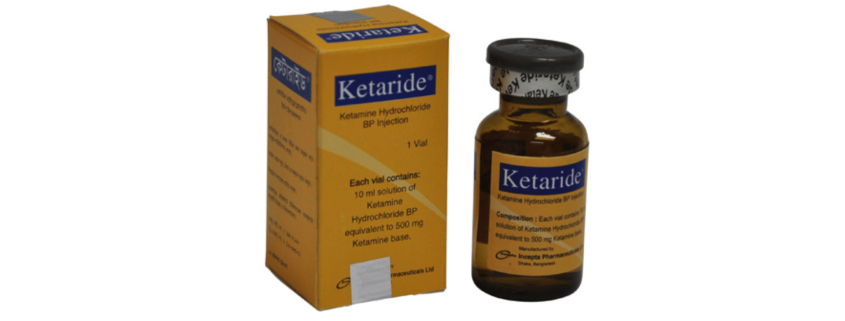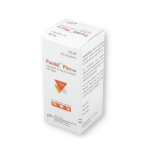Ketaride(Ketamine)

Therapeutic Group: Anesthetic / Critical Care
Presentation
Each vial contains 10 ml solution of Ketamine Hydrochloride USP equivalent to 500 mg Ketamine base.
Description
Ketaride (ketamine as hydrochloride) is a non-barbiturate anesthetic. Ketamine is a racemic mixture. It is formulated as an acid (pH 3.5 to 5.5) solution for intravenous or intramuscular injection.
Indications
Ketaride is recommended:
As the sole anesthetic agent for diagnostic and surgical procedures that do not require skeletal muscle relaxation. Ketaride is best suited for short procedures and it can be used with additional doses, for longer procedures.
For the induction of anesthesia prior to the administration of other general anesthetic agents.
To supplement low-potency agents, such as nitrous oxide.
Dosage & Administration
Adult:
General Anesthesia-
1. IV Induction: 1-4.5 mg/kg single dose
2. IM Induction: 6.5-13mg
3. IV Infusion: 1-2mg/kg at 0.5mg/kg/min
4. Maintenance: The maintenance dose should be adjusted according to the patient’s anesthetic needs and whether an additional anesthetic is employed. Increments of one-half to the full induction dose may be repeated as needed for maintenance of anesthesia.
Rapid sequence Intubation, Induction – 2mg/kg IV
Pediatric:
General Anesthesia:
1. IV Induction: 1-2 mg/kg IV; range: 4-13 mg/kg
2. IM Induction: 5-10 mg/kg; range: 0.5-4.5 mg/kg
3. Maintenance: 0.01-0.03 mg/kg/min continuous IV infusion
The maintenance dose should be adjusted according to the patient’s anesthetic needs and whether an additional anesthetic is employed. Increments of one-half to the full induction dose may be repeated as needed for maintenance of anesthesia.
Rate of Administration: It is recommended that ketamine should be administered slowly (over a period of 60 seconds). More rapid administration may result in respiratory depression and enhanced pressor response.
Note: The 100 mg/ml concentration of ketamine should not be injected intravenously without proper dilution. It is recommended the drug be diluted with an equal volume of either Sterile Water for Injection, USP, Normal Saline, or 5% Dextrose in Water.
Dilution: To prepare a dilute solution containing 1 mg of ketamine per ml, aseptically transfer 10 ml (50 mg per ml vial) to 500 ml of Dextrose Injection, 5% or Sodium Chloride Injection, 0.9% and mix well. The resultant solution will contain 1 mg of ketamine per ml.
Side Effects
Cardiovascular – Blood pressure and pulse rate are frequently elevated following administration of ketamine. However, hypotension and bradycardia have been observed. Arrhythmia has also occurred.
Respiration – Although respiration is frequently stimulated, severe depression of respiration or apnoea may occur following rapid intravenous administration of high doses of ketamine laryngospasm and other forms of airway obstruction have occurred during ketamine anesthesia.
Eye – Diplopia and nystagmus have been noted following ketamine administration. ketamine may also cause a slight elevation in intraocular pressure measurement.
Neurological – In some patients, enhanced skeletal muscle tone may be manifested by tonic and clonic movements, sometimes resembling seizures.
Gastrointestinal – Anorexia, nausea and vomiting have been observed. However this is not usually severe and allows the great majority of patients to take liquids by mouth shortly after regaining consciousness. Hypersalivation has also been observed.
Precautions
Monitor cardiac function; patients with eclampsia or preeclampsia, history of convulsive or psychiatric disorders.
Warnings and Precautions:
Ketamine should be used by or under the direction of medical practitioners experienced in administering general anesthetics and in maintenance of an airway and in the control of respiratory support.
Barbiturates and ketamine, being chemically incompatible because of precipitate formation, should not be injected from the same syringe.
Prolonged recovery time may occur if barbiturates and/or narcotics are used concurrently with ketamine.
Post-operative confusional states may occur during the recovery period
Because pharyngeal and laryngeal reflexes are usually active, ketamine should not be used alone in surgery or diagnostic procedures of the pharynx, larynx or bronchial tree.
Mechanical stimulation of the pharynx should be avoided, whenever possible, if ketamine is used alone. Muscle relaxants with proper attention to respiration, may be required in both of these instances.
Resuscitative equipment should be ready for use.
The intravenous dose should be administered over a period of 60 seconds. More rapid administration may result in respiratory depression or apnoea and enhanced pressor response.
Abuse Potential – Ketamine has been reported being used as a drug of abuse. Reports suggest that ketamine produces a variety of symptoms including, but not limited to, flashbacks, hallucinations, dysphoria, anxiety, insomnia, or disorientation. Ketamine dependence and tolerance may develop in individuals with a history of drug abuse or dependence. Therefore, ketamine should be prescribed and administered with caution.
Use in Pregnancy & Lactation
Pregnancy: The safe use of ketamine in pregnancy has not been established, and such use is not recommended.
Lactation: Ketamine is likely to be excreted in breast milk and therefore breastfeeding should be discontinued when ketamine is in use.
Drug Interaction
Halogenated hydrocarbon inhalational anesthetics may prolong the half-life of ketamine; recovery from anesthesia may be prolonged following concurrent use. Concurrent use of ketamine (especially in high doses or when rapidly administered) with halogenated anesthetics can increase the risk of developing bradycardia, hypotension, or decreased cardiac output.
Prolonged recovery time may occur if barbiturates and/or narcotics are used concurrently with ketamine.
Benzodiazepines may prolong the half life of ketamine; recovery from anesthesia may be prolonged following concurrent use.
Co-administration of drugs with a hypertensive effect (eg. ergometrine) should be avoided.
Sustained rises in arterial pressure have been reported in patients receiving concomitant ketamine and thyroxine.
Clinically apparent reduction in seizure threshold has been reported in patients receiving concomitant ketamine and theophylline. Unpredictable extensor-type seizures have been reported with concurrent administration of these agents.
There is no information available on the interactions between ketamine and antihypertensive agents. However, given the marked increase in arterial pressure following administration of ketamine, cardiac function should be monitored
Ketamine is clinically compatible with the commonly used general and local anesthetic agents when an adequate respiratory exchange is maintained.
Ketamine may potentiate the neuromuscular blocking effects of atracurium and tubocurarine, including respiratory depression with apnoea.
The use of ketamine with other central nervous system (CNS) depressants (eg. ethanol, phenothiazines, sedating H1-blockers, or skeletal muscle relaxants) can potentiate CNS depression and/or increase risk of developing respiratory depression. Reduced doses of ketamine may be required with concurrent administration of other anxiolytics, sedatives, and hypnotics.
Ketamine has been reported to antagonise the hypnotic effect of thiopental.
Patients taking thyroid hormones have an increased risk of developing hypertension and tachycardia when given ketamine.
Concomitant use of antihypertensive agents and ketamine increases the risk of developing hypotension.
Over Dose
Respiratory depression may occur with overdosage or too rapid rate of administration of Ketaride , in which case, supportive ventilation should be employed. Mechanical support of respiration is preferred to administration of analeptics.
Ketamine has a wide margin of safety; several instances of unintentional administration of overdoses of Ketaride (up to 10 times that usually required) have been followed by prolonged but complete recovery.
Storage
Store at controlled room temperature, 15° to 30°C (59° to 86°F).
Color of solution may vary from colorless to very slightly yellowish and may darken upon prolonged exposure to light. This darkening does not affect potency. Do not use if a precipitate appears. Protect from light.
Commercial Pack
Each box contains 1 vial containg10 ml solution of Ketamine Hydrochloride USP equivalent to 500 mg Ketamine base.



